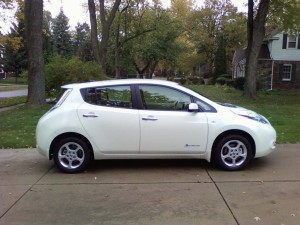
While overall car sales are strong for June, falling fuel prices have hurt demand for hybrids and electric vehicles like the Nissan Leaf.
Once again, the U.S. auto industry appears to be in the driver’s seat when it comes to an otherwise-anemic American economy. Sales of new vehicles are looking likely to post double-digit gains over June 2011 numbers, according to industry analysts, straining industry production capacity.
Several automakers, including Ford and Hyundai, warn that demand is outstripping supply and that they might see lower market share because of factory bottlenecks.
J.D. Power and Associates and LMC Automotive of Troy estimate June’s new vehicles sales are up 15% compared to June of 2011. June’s new-vehicle sales rate is approaching a 12 million-unit pace on the retail side alone, the strongest level since February, according to a monthly sales forecast by the consulting partners.
Overall, the market appears to be on an annualized sales pace approaching 14.5 million including fleet sales, according to various analysts. But the market appears to be shifting away from the high-mileage and alternative-power vehicles that gained traction last spring.
As gas prices increased from $3.33 per gallon in November 2011 to $3.84 per gallon in April 2012, the combined share of retail sales of hybrid and electric vehicle sales increased from 1.7% to 4.6% during the same period. With fuel prices now at their lowest levels since the beginning of the year, demand for those high-mileage products has been trending downward during the past two months and is now at 3.4%.
“The hybrid and electric vehicle market closely follows gas prices, which demonstrates that while there is consumer interest in hybrid and electric vehicles, demand is heavily influenced by the economic environment, rather than pure interest in the technology ,” said John Humphrey, Power’s senior vice president of global automotive operations.
“Until we see alternative power train growth without rising gas prices, we won’t see the market share growth that many automakers are hoping for,” said Humphrey, who stressed that overall car sales are still looking robust.
The trend is positive, Humphrey indicated, as the industry enters the typically strong summer selling season and the first of the 2013 model-year vehicles start to roll into showrooms.
And the momentum appears to be building without heavy manufacturer support. Average incentive levels, while up 9% versus a year ago, are down 5% from May of 2012.
“All indicators point toward an industry that continues to get healthy,” Humphrey added.
Total light-vehicle sales in June are expected to come in at 1,265,900 units, which would be a 16% increase from June 2011, according to Power. Fleet volume as a percentage of total light-vehicle volume is expected to reach 21%in June, after falling below 20% in May.
After two months of upward revisions to the 2012 forecast, LMC Automotive is maintaining its total light-vehicle sales forecast for 2012 at 14.5 million units with retail sales accounting for 11.6 million units.
That is in line with upgraded forecasts from a number of manufacturers, including General Motors and Toyota.
“Despite a rising level of uncertainty with the economic recovery, consumers remain resilient in their willingness to purchase new vehicles,” said Jeff Schuster, senior vice president of forecasting at LMC Automotive. “Concerns regarding the macro-economic environment and another potential summer slowdown have increased, but we expect the sales pace to remain strong and stable throughout the second half of the year.”
Meanwhile, North American light-vehicle production is well ahead of the increase in U.S. sales, with production volume up nearly 23%, compared with the same period in 2011. More than 1.2 million additional vehicles have been built in the first five months of 2012, compared with the same period in 2011, as manufacturers – especially the Japanese – race to rebuild dealer inventories.
U.S. manufacturing growth continues to lead the overall North America region with a 26% year-to-date increase. Production in Mexico is up 14%, and Canadian manufacturing is 19% higher.
Vehicle inventory at the beginning of June declined slightly to a 52-days supply. Passenger car inventory remains at a below-normal level, with a 43-days supply in early June, down from 45 days in early May. Truck inventory is at normal levels with a 61-days supply, down from a 67-days supply in May.
“Despite the significant increase in production levels this year, vehicle inventory has remained at a level that is below the typical 60- to 65-days supply,” said Schuster.
